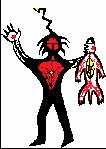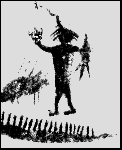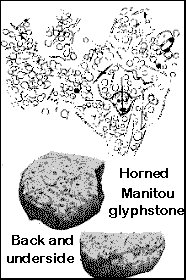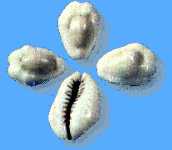Morrisseau: Influence of Rock Art and Birchbark Scrolls
| In the 1950's and
'60's Morrisseau traveled widely to bush communities in Canada and
visited some northern Minnesota reservations. He met with many who today
are considered knowledgeable elders, both to learn from them and to
teach. He visited many sacred sites where there are petroglyphs both
carved and painted on the stone, places quite hard to reach, generally
unknown. He taught by painting, as well as (later) writing.
One of Medicine Painting's features is the so called "mystic x-ray vision" where animal spirits (and sometimes people) are shown with non-anatomical symbolic-patterns insides, representing internal powers, rather than guts. Projections -- hooks, points, rays -- indicate various forms of power radiating from the beings, and connecting lines indicate either " power directed to" or a causal connection of some type. Most of these conventions of symbolism are found in very ancient rock carvings and paintings all over the Great Lakes and Canadian Shield. They are also preserved incised on birchbark scrolls, which recorded history, Midè knowledge, and songs. Mide sky figure is one of 2 ink drawings brought to Akwesasne Notes in 1974 by some young artists visiting from Manitoulin Island Odawa Reserve. The style is medicine painting. I was told the two drawings represent constellations -- this is Orion, the hunter. He is a sky-medicine healer, with an otter-skin medicine bag (which shoots curing Megis shells into people who are ill at Midewiwin grand ceremonies). From his head is a direct lightning-like connection to sky-power. I recognized the style as similar to Morriseau's, but thought it was one of his students. While researching for this essay I came across the rock painting (a poor, reconstructed photo of it is shown above). Morrisseau knew about this. It was located along a rough, shortcut canoe route from Lac Seul to Lake Winnepeg, along the Bloodvein drainage. He took Selwyn Dudeny, author of a book about birchbark scrolls, there, and Dudeny photographed the Sky Mide rock figure. It's the obvious source of the drawing I now believe must have been made by Morrisseau himself, and brought to Notes by a student from the Manitoulin summer art-school. Those students -- who are far from the Winnipeg canoe route -- would not have seen the rock painting, as Morrisseau did. Along the Bloodvein from the wst shore of Lake Nipigon (where Morrisseau's grandparents' home was) to Lake Winnipeg is a route that Morrisseau took Selwyn Dewdeny in the early 1960's, showing him rock art. The rock art skyman is photographed in Dewdeny's book, The Sacred Scrolls of the Southern Ojibway. Since Morrisseau guided him on his explorations seeking rock art, Morrisseau certainly saw it, and seems to have been quite directly inspired by it. Petroglyphs, or rock art as it is coming to be called, is (or used to be) found all over the U.S. and Canada. Petrographs -- paintings on the stone -- were usually meant to be renwed in periodic ceremonies. Most have faded badly, remaining barely legible. Petroglyphs, carven in stone, last better, but are subject to weathering and vandalism. Most people tend to think they are found only in the southwest and California, but this is not so. You can see a few of the thousands of Jeffers petroglyphs located in a shortgrass prairie ares of southwestern Minnesota, among quartzite boulders, near a mile-long line of boulders that is probably a solstice sunrise marker. In Ontario, sits can be visited at Petroglyphs Provincial Park., and there is another extensive northern site in Sanilac, Michigan. Here is a page with many images and links to rock art images worldwide.
Those familiar with southwestern art will recognize the similarity of the asymetrical horns to certain kachinas and to ancient rock art of the Anasazi peoples. But for Anishinaabeg and related woodland peoples from Quebec throughout the northern woodland-lakes area, these rock figures also appear on birchabark scrolls, used as ceremonial, story and song mnemonics. They represent Manitous, often the Manitous of the 4 directions. Morrisseau uses many motifs from this ancient rock art and its more modern (but still antique) birchbark recordings. Skyman is holding up a Midèwewin otter-skin medicine bag -- a midèwayaan -- made of an otter skinned with the head, paws and tail left on, the flesh and bones drawn out through a slit in the throat. Paws and tail are usually beaded. In Midè cermonies, initiates who are there for healing are shot by Midèwinini, who point the bag's nose at the patient-initiate. The patient is killed by the Migiis shells that fly into his or her body, which are later recovered, when the patient rises, having been healed by the repeated shootings, songs, and prayers.
Migiis shells, that is cypraea moneta the little white cowrie, have ben found in earth mounds forgotten in forests, long before the first known white contact. Since they grow only in south Pacific island waters, their prevalence in pre-contact days -- and the enormous respect and reverence in which they are held in Anishinaabeg religion -- is hard to explain. These shells have been immediatly valued and desired by every so-called primitive people, when introduced by traders. African traderes spoke of the "apparently insatiable demand" for this little shell, for example. It is as if every tribal people recognizes something very special about the undistinguished little shell. Other cowries are larger, more colorful, and are liked for ornament, but this one is reverencd. The vertical strip shows 4 of a variety of
representations of Migiis shells on a number of sacred Anishinaabe
Origin scrolls, where the story and ceremonies for reenactment of |
|---|
http://kstrom.net/isk/art/morriss/mor_rock.html
All text and graphics at this site copyright 1995, 1996,
1997 by Paula Giese
This site hasn't been updated since 1997 so unless you convince me the site is going to stay up and safe I'm keeping this valuable up and running and it ha nothing to do with financial gain of any kind.
 I named this sky-figure Mide Skyman
I named this sky-figure Mide Skyman Morrisseau
would give paintings and drawings to people he stayed with back in the
far shabby parts of reservations where government money and jobs never
reaches, where the traditional old people tend to live.
Morrisseau
would give paintings and drawings to people he stayed with back in the
far shabby parts of reservations where government money and jobs never
reaches, where the traditional old people tend to live. Prairie
glyphstones -- carvings on boulders ranging down to hand-sized rocks --
were once fairly common on the shortgrass prairies of Canada. No one
knows, now what they mean: shrines, trail-markers, records of some kind
of historic event at the site? This is a tracing and two photo-views of
the Trochu glyphstone "unrolled". It is carved on all flat, smooth
portions. Top -- with the horned Manitou -- and bottom are photographed.
The Glenbow museum holds these and other prairie gluyphstones. Tracing
and photos were made by Selwyn Dudeney, who was field-studying Canadian
rock art for the Alberta-Glenbow Institute in 1960; it had not yet
become a museum.
Prairie
glyphstones -- carvings on boulders ranging down to hand-sized rocks --
were once fairly common on the shortgrass prairies of Canada. No one
knows, now what they mean: shrines, trail-markers, records of some kind
of historic event at the site? This is a tracing and two photo-views of
the Trochu glyphstone "unrolled". It is carved on all flat, smooth
portions. Top -- with the horned Manitou -- and bottom are photographed.
The Glenbow museum holds these and other prairie gluyphstones. Tracing
and photos were made by Selwyn Dudeney, who was field-studying Canadian
rock art for the Alberta-Glenbow Institute in 1960; it had not yet
become a museum.  Migiis
shells are small white cowries that grow only on reefs in the South
Pacific ocean. There, they have been called "money cowries" because of
the great value the islanders give them. (It seems likely that these
shells' values were sacred, they may have served a function like wampum,
to record. White men also believed the Indians considered wampum to be
like money, though this is not true.) In Ojibwe religious and cultural
thought, Migiis is a great white shining cowrie shell in the sky, which
led the Anishinaabeg on their long migration from the shores of the
Atlantic to the west, around the Great Lakes. Migiis represents the sun.
Migiis
shells are small white cowries that grow only on reefs in the South
Pacific ocean. There, they have been called "money cowries" because of
the great value the islanders give them. (It seems likely that these
shells' values were sacred, they may have served a function like wampum,
to record. White men also believed the Indians considered wampum to be
like money, though this is not true.) In Ojibwe religious and cultural
thought, Migiis is a great white shining cowrie shell in the sky, which
led the Anishinaabeg on their long migration from the shores of the
Atlantic to the west, around the Great Lakes. Migiis represents the sun. the Creation story are recorded in pictorial mnemonics and diagrams.
These take many years to learn -- the story and all the songs. Most of
the birchbark scrolls are now lost. Those in museums cannot, in general,
be understood unless by someone who spent decades of apprenticeship with
a Midèwinini, learning them all. The picture and symbols are not a
written language; they are mnemonics, reminders. Variants of these
symbolic representations of the little migiis shell appear in
Morrisseau's paintings often.
the Creation story are recorded in pictorial mnemonics and diagrams.
These take many years to learn -- the story and all the songs. Most of
the birchbark scrolls are now lost. Those in museums cannot, in general,
be understood unless by someone who spent decades of apprenticeship with
a Midèwinini, learning them all. The picture and symbols are not a
written language; they are mnemonics, reminders. Variants of these
symbolic representations of the little migiis shell appear in
Morrisseau's paintings often.